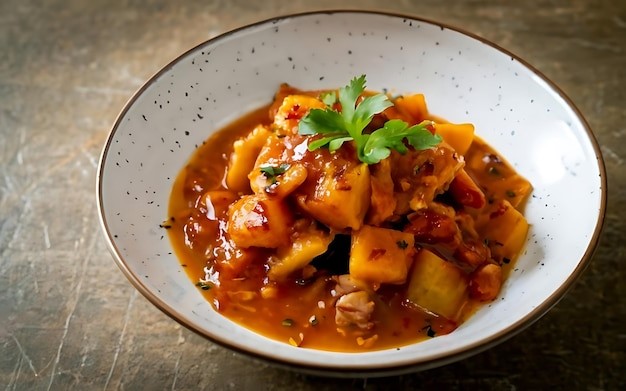If there’s one dish that captures the essence of Goan celebration, it’s Sorpotel. Rich, spicy, and tangy, Sorpotel is not just a recipe — it’s tradition, culture, and comfort in every bite. This beloved Goan pork dish features tender chunks of meat simmered in a robust, vinegar-based sauce bursting with the warmth of local spices. Whether served during Christmas, weddings, or a casual Sunday lunch, Sorpotel always finds a place on the Goan table.
Sorpotel Defined
Originating from Goa’s Portuguese-influenced cuisine, Sorpotel (also spelled Sarapatel) is a hearty pork stew traditionally made with a mix of pork meat and liver. The dish is known for its piquant, vinegary gravy, which gets better as it sits — making Sorpotel a dish that’s even more delicious a day or two after it’s made.
While its roots are in Portuguese cuisine (specifically from the dish sarapatel), Goan Sorpotel has taken on a distinct identity over the years with the addition of local chilies, spices, and a generous splash of palm vinegar.
Key Ingredients in Sorpotel
What makes Sorpotel unique is its balance of rich pork, spicy masala, and tangy vinegar. Here’s what goes into a classic version:
- Pork (often a mix of belly, meat, and liver for depth of flavor)
- Goan vinegar (traditionally toddy or coconut vinegar)
- Onions
- Garlic and ginger
- Red chilies (preferably dried Kashmiri chilies for vibrant color and mild heat)
- Cinnamon, cloves, peppercorns, cumin
- Turmeric and garam masala
- Sugar (to balance the tanginess)
- Salt to taste
Some variations may include blood or offal, but most home versions focus on boneless pork and liver, for richness without being overpowering.
How Sorpotel is Made
Making Sorpotel at home is a labor of love, but the steps are simple if taken one at a time:
1. Boil and Dice the Meat
The pork and liver are first boiled, then cut into small cubes. This step is important for getting the perfect texture — soft, yet not mushy.
2. Fry the Meat
The diced meat is lightly fried to give it a bit of crispness and flavor. It also helps seal in the juices before simmering in the gravy.
3. Prepare the Masala
A masala paste is made using roasted red chilies, garlic, ginger, and dry spices. This is sautéed until fragrant, then deglazed with vinegar and a bit of water.
4. Slow Simmer
The fried meat is added back to the masala and allowed to simmer slowly. This is when all the flavors come together — the vinegar mellows, the spices bloom, and the meat absorbs every note.
How to Serve Sorpotel
Sorpotel is traditionally served with:
- Sannas (steamed Goan rice cakes)
- Pão (Goan bread rolls)
- Steamed rice for a hearty meal
It’s also common to pair Sorpotel with dosas or chapatis outside of Goa.
And here’s the secret: Sorpotel tastes better the next day. Like many slow-cooked dishes, resting time allows the flavors to deepen and intensify.
A Dish That Tells a Story
Sorpotel is more than just food — it’s a reflection of Goa’s culinary fusion of Portuguese and Indian influences, a reminder of how tradition can be preserved through taste. From Christmas feasts to Sunday family lunches, this dish brings people together in celebration of flavor and heritage.
If you’re ready to explore the bold, complex world of Goan cuisine, Sorpotel is a great place to start. It may take a little time to prepare, but the result is absolutely worth it: tender meat in a spicy, tangy, soul-satisfying gravy.
So roll up your sleeves, turn on some music, and let your kitchen fill with the aromas of Goa. With every spoonful of Sorpotel, you’re not just enjoying a dish — you are tasting history.









